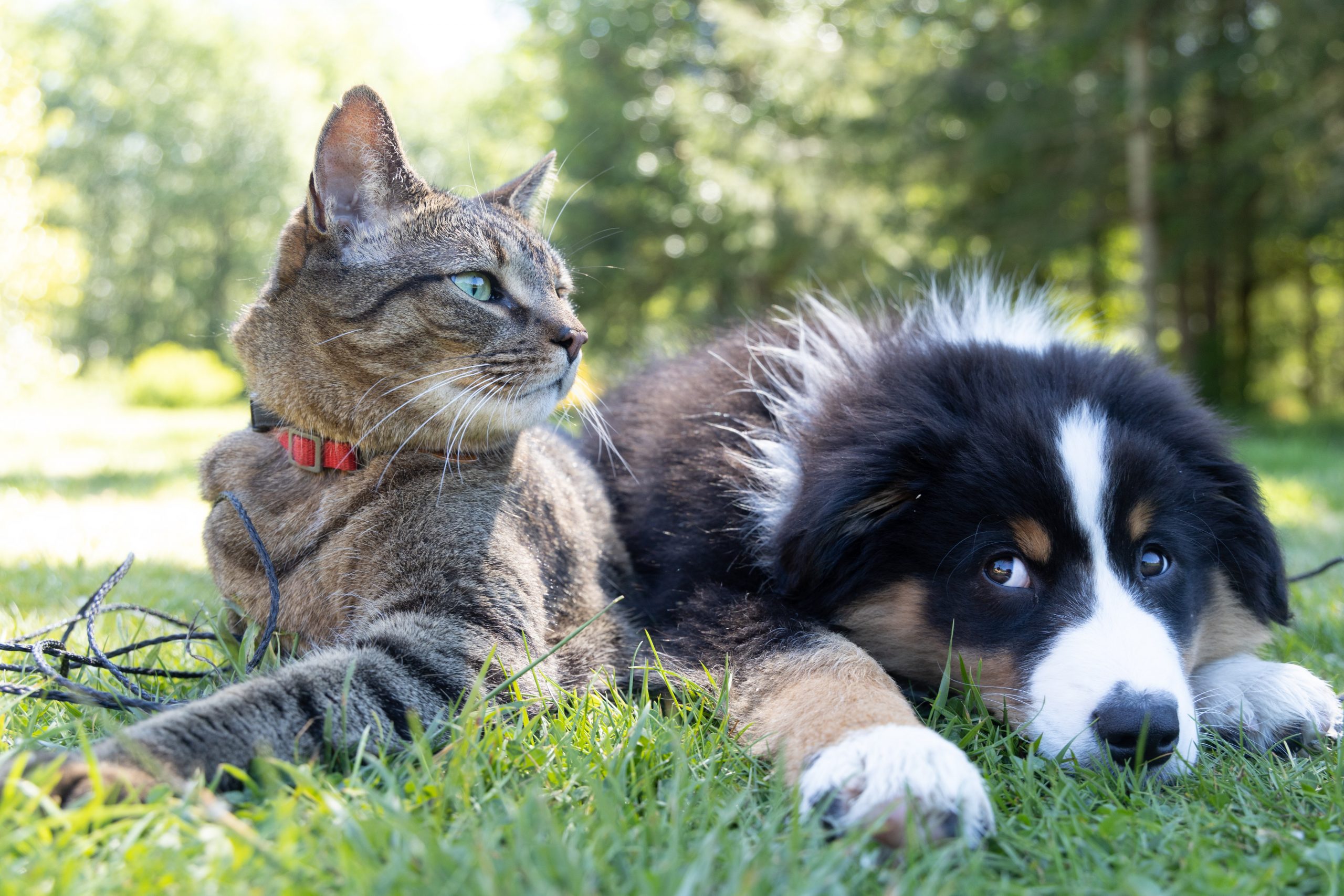By Alex Eaton, owner of Healing Bay Pet Nutrition.
Adopting a Dog or Cat. Congratulations! You have made the wonderful decision to adopt a furry family member. It’s an exciting feeling, but figuring out the next steps can be a little daunting — especially for those new to pet parenting. Whether you’re adopting a new fluffy puppy or a senior kitty, here are some important tips and tricks you need to know to build a strong relationship with your new pet — and ensure they have proper care from the moment they arrive home.
Prepare in advance
First thing’s first. Before bringing home your new furry friend, you need to be prepared. The following steps can guide you through this process to ensure you have thought of everything:
-
Make a potty training plan
This is always a hurdle for new puppies, and sometimes even adult dogs — although adults are much easier to train than puppies. Luckily, you can choose from lots of dog trainers online.
-
Consider behavioral training
Setting boundaries with your dog from the beginning will make both of your lives more enjoyable. What’s more — it’s important to establish rules to help your dog socialize with other dogs and people appropriately.
-
Find a groomer
Grooming is essential for any long-haired cat or dog. Dogs with long coats will require regular grooming. This is a must for the health and comfort of your new family member. For puppies, grooming should begin at 12 weeks old to get them used to the groomer. For older dogs, it may be stressful to begin grooming if they aren’t used to it, but mobile groomers have a lot of experience with this. Communicate with your pet pro ahead of time if your pet is skittish or nervous, so they can adjust their care in line with your pet’s needs.
-
Find a veterinarian that you trust
There is no short supply of vets offering care, including vaccines, surgery, emergency care, and more. A new wave in veterinary medicine also includes integrative or holistic vets. These doctors often still use all of the conventional therapies, but they also have many extra modalities. They will focus on things like nutrition, science-backed vaccine protocols, acupuncture, and supplements if needed. Finding a mobile veterinarian you like sometimes means trying out multiple clinics because it is so important to have someone you can trust
What else do I need before my pet comes home?
Now that you’re squared away with a trainer, groomer, and veterinarian, you need to consider what things you should have ready at home for your new pet. There are so many pet products on the market — you may be asking yourself where do I begin. To make it easier for you, here’s a list to start with.
New Dog Checklist:
- Food
- Collar and tag (Never attach a leash to a flat-buckle collar)
- Leash
- A harness or training collar (These are the only things a leash should be attached to)
- Flea & tick prevention (Depending on the season and where you live)
- Training treats (I recommend single ingredient treats, such as freeze dried liver)
- Bowls (Try to stick with stainless steel, as this reduces bacteria build-up)
- Bed
- Toys (Ask the shelter staff if there are toys your dog or puppy has enjoyed, so you don’t waste money on something they won’t play with)
- Chews (Single ingredient, natural chews are always best)
- Shampoo (Your new canine companion may be dirty when they first come home from the shelter)
- Brush (Depending on their type of coat)
- Crate (I recommend a crate for every dog. If adopting a puppy, make sure to get one large enough for their adult size. A good crate will come with a divider to cut down the space while they are still growing)
- Toothbrush and paste
- Nail trimmer, or find a nail trimming service (Overgrown nails can cause permanent damage to a dog’s musculoskeletal structure)
- Ear cleaner (Essential for certain breeds including spaniels and retrievers, but generally optional for most breeds if they are not fed processed food)
- Probiotics (Not required, but highly recommended to prevent digestive upsets from this huge transition in the dog’s life)
- Coat/rain jacket
- Calming products (These may help your new canine companion adjust better)
New Cat Checklist
- Food
- Training treats (Most people don’t think of it, but training cats can be just as important as dogs)
- Litter box and scoop
- Litter (Try opting for an environmentally friendly choices, like corn-based, walnut-based, wheat-based, wood-based, and recycled paper. Avoiding clay is not only better for the environment, but also important for your respiratory health, as well as your cat’s)
- Bowls (Stainless steel is best for cleanliness, and make sure they are shallow and wide. A lot of cats won’t eat if their whiskers touch the edge of the bowl)
- Water fountain (Cats naturally have a low thirst drive, but fluid intake is essential to keep their kidneys healthy)
- Toys (Cats are incredibly playful creatures, especially when kittens. Buying a variety of small, inexpensive toys is a great starting point)
- Nail trimmer (This is absolutely essential. If you don’t do it yourself, you must have someone else do it. There are specific nail trimming companies, and any vet or groomer will also do it for you)
- Scratching post
- Flea & tick prevention (Is your cat indoor or outdoor? Do you have any other pets that go outside? This may be optional)
- Probiotics (Not required, but highly recommended to prevent digestive upsets from this huge transition in the cat’s life)
- Toothbrush and paste
- Ear cleaner (Usually only necessary for seniors that can’t clean their own ears properly anymore)
- Brush (Make sure you are brushing your kitty often! This helps with hairballs and other digestive issues, as well as keeping the skin and coat healthy)
- Nail caps (Even if your new pets’ nails are trimmed, cats can inflict damage on your furniture. These are available online or at your local small pet store)
- Sticky Paws furniture tape (This will also save your furniture, especially if you have kittens. It can be applied to just about anything your cat tries to scratch)
- Calming products (these are important in helping your new kitty adjust better)
Last but not least…
What food should I give my new pet?
If possible, find out what your pet was eating in the shelter and keep them on that for at least two weeks, or possibly up to four. You can start switching to a better food if they seem right at home after a week or two. However, if they are still nervous after a few weeks, give it more like a month to allow them to settle in.
What does your new pet settling in have to do with their food? Good question! It is a lot for any animal to transition from the shelter into your home, not to mention whatever life they had prior to the shelter. The next biggest change that could happen to them is a change in diet. This is why it’s important to try to not switch the food too soon or suddenly, as they are still adjusting to a new home and humans already.
Once you get your new furry family member home, you should consult a certified animal nutritionist with experience with new rescue pets. They can not only guide you on how to switch foods, and what to feed, but also give training and behavior tips, and specific recommendations on products to purchase.
About the Author

At five years old, Alex knew she wanted to be a veterinarian to heal animals of all shapes and sizes. At 10, she got her first job, caring for the animals at a local pet shop. This gave her the opportunity to expand her knowledge and experience with animal care. She enjoyed this work so much, this job eventually turned into a management position at the store. Along the way, she soaked up every bit of knowledge she could on all things related to pet nutrition. She quickly saw the power of real food, and combined with her knowledge of herbs and homeopathy, she was seeing some amazing results.
After completing a Clinical Pet Nutritionist certification from ANHS, Alex started Healing Bay Pet Nutrition, with the goal of expanding her reach in healing dogs and cats. This certification solidified her experiences with real food, and expanded her abilities with various holistic modalities, such as herbs, homeopathy, and flower essences. She wants to make the world a better place for all animals, and making small changes one pet at a time, feels like a really good start.


